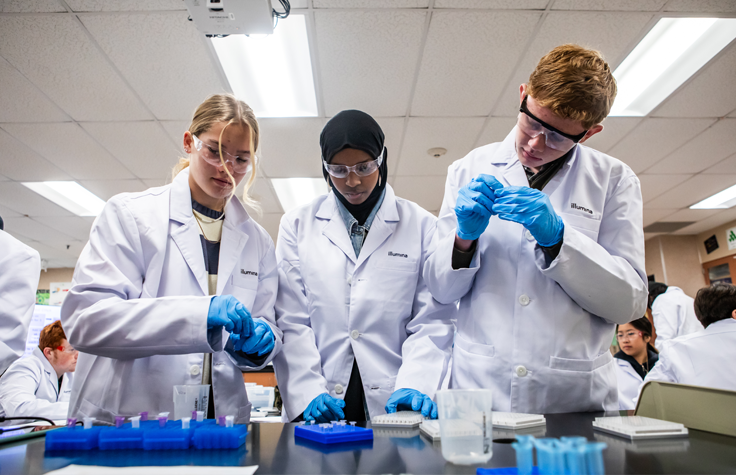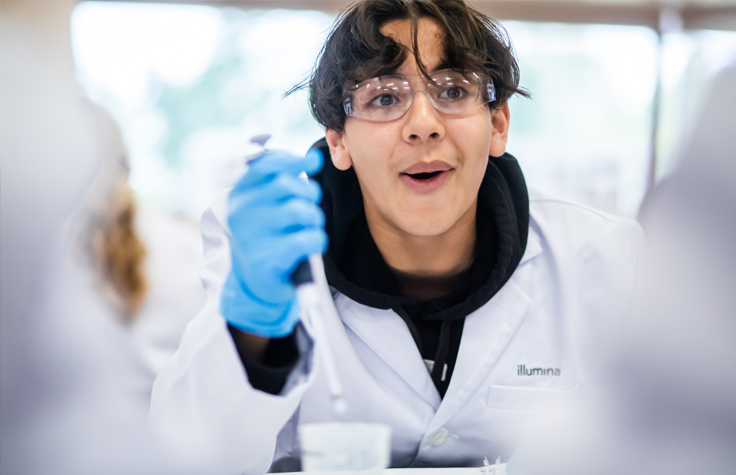
27 March 2024
Next-generation sequencing (NGS) provides amazing insights into health care, agriculture, food safety, and many other disciplines, making it increasingly essential for students to have access to this technology to enhance their career options. To make that happen, the Illumina Genomic Discoveries program and Biocom California’s Generation STEAM are partnering to bring NGS education to San Diego–area high schools.
“We developed a ‘Lab-in-a-Box’ program to empower teachers and expose students to our technology and then partnered with Biocom California to roll it out and potentially scale it,” says Vanessa Light, senior manager of Corporate Social Responsibility at Illumina. “We train teachers on an Illumina benchtop sequencer, and then they have the opportunity to bring the sequencer into their classrooms and put it in the hands of students.”
Lab-in-a-Box includes an iSeq 100 System and all the materials necessary to conduct powerful experiments, like those performed in biotech labs. The program also supports teacher development by sharing information about industry tools, trends, and careers.
“It’s important to give teachers access to these skills and resources,” says Mikayla Ortega, Generation STEAM’s program manager. “There’s a multiplier effect: If we impact one teacher, we can reach 40 or even 200 students. In turn, they start seeing themselves as scientists, engineers, and strategic thinkers.”
Genomic discoveries in action
Sixteen teachers in San Diego County are already incorporating Lab-in-a-Box into their curricula. One is Elizabeth Perkoski, a career technical education (CTE) biotechnology teacher at El Camino High School, a Title 1 school in Oceanside.
“The sequencer is fantastic, but the program touches on so many important skills,” says Perkoski, who teaches ninth graders. “The students learn foundational bench science techniques, like pipetting and PCR, which amplifies DNA segments. They learn how sequencing works and conduct bioinformatics on the back end. It’s a little bit of everything, and it gives them real-world experience.”
The sequencing experiment is built around a familiar scenario: food contamination. Its premise is that a salad made conference attendees sick, and students must identify the specific vegetable and pathogen causing the outbreak. The class is given several vegetables and must analyze their surfaces to find answers. (Spoiler alert: The tomatoes are infected with E. coli.)
“They get really excited because they’re familiar with that storyline,” Perkoski says. “They’ve heard about romaine lettuce being pulled off shelves, so it gives them a window into what’s going on behind the scenes.”

A student of the Lab-in-a-Box program has a eureka moment. Photo: Kristy Walker
The STEAM pathway
Perkoski designed this biotech unit in 2019 as an alternative to traditional biology lessons. She still covers all the ninth-grade bio standards—ecology, evolution, cells, and DNA—but layers on biotech to give students a better feel for how the science is applied.
The unit is part of a two-class CTE certification. The second class, the capstone, will immerse students even more deeply in the biotech ecosystem, giving them opportunities to meet scientists, visit biotech campuses, and possibly apply for internships. Perkoski is working with Oceanside’s MiraCosta College to offer course credit.
“MiraCosta offers a bachelor's degree in biomanufacturing, and there’s an intro course they want me to design the capstone around,” Perkoski says. “I’d also like to have formal labs and introduce students to possible careers in research. They’ll learn about protein purification and standard techniques, like ELISA [enzyme-linked immunosorbent assay], and even keep lab notebooks.”
Seeing the students grow is a major highlight for her. On day one, many of them can’t even define “biotechnology.” But as the class progresses, they develop a better appreciation for both the science and the industry. In some cases, individuals gravitate to specific parts of the sequencing workflow—kids with computer skills often home in on bioinformatics. Even more importantly, the unit helps students envision a career in STEAM.
“A lot of our students, especially girls, come in thinking they're bad at science,” Perkoski says. “It's just already planted in their minds. But by the end of the year, they feel a lot more confident and excited about it, and that’s great to see.”
Perkoski wants her students to understand that there’s more to life sciences than lab work. The industry needs trainers, salespeople, writers, designers, engineers, and other professionals. The best part is that all this exists in their backyards, since San Diego has a concentration of biomedical companies. But on an even deeper level, she wants them to walk away knowing that science is cool.
“My goal is to get them excited about science,” she says. “I tell them, ‘If you leave this class and don't remember anything, that’s fine. But if you leave this class excited about science and wanting to figure stuff out, that’s my goal. I win.’”
Illumina’s long-term mission relies on nurturing and equipping the emerging life sciences workforce. By supporting educators like Elizabeth Perkoski to become genomics advocates, we nurture the next generation and give them new career options. Learn how we are increasing equitable access to STEAM and genomic education here.


